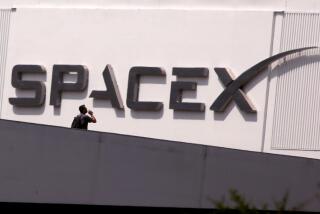Space Vector Pins Fortunes to Rise of Star Wars Missiles
At Space Vector, things have been going in the right direction lately--up--and the reason is the space-based missile defense plan popularly known as Star Wars.
On Sept. 5, an Aries rocket made by Space Vector was launched from the White Sands Missile Range in New Mexico, part of the most sophisticated test so far in President Reagan’s Strategic Defense Initiative.
The test was cause for celebration at the company’s Northridge headquarters. It marked NASA’s first successful launch after three failures.
Then, last week, Space Vector got a big boost in the form of a multi-year contract from Lockheed said to be worth at least $10 million. Space Vector said the deal could increase its employment from 80 to as much as 120 by late 1988.
The contract, also part of the SDI program, calls for Space Vector to build prototype interceptor missiles from surplus military hardware and other supplies. The missiles are designed to intercept enemy warheads, and Space Vector will make everything but the engines and the projectile that intercepts the warheads itself.
$468-Million Army Contract
The deal stems from Lockheed’s five-year, $468-million contract with the Army to build at least five ground-based missiles capable of destroying nuclear warheads in space.
As a small company known for its relatively inexpensive prototype missiles, Space Vector hopes to find a continuing niche in Star Wars.
“We’re trying to be the darlings of SDI,” said Joseph H. Herger, 56, president of Space Vector since July and previously a technical consultant for the company.
Space Vector, with sales last year exceeding $4 million, has tripled its $5-million order backlog with the new Lockheed contract. The deal could invigorate a company whose sales are down from about $6 million as recently as two years ago.
Worked on Minuteman
Before emerging as a missile designer, Space Vector made a name for itself by specializing in equipping spacecraft to fly or spin straight or upright. Its controls are known as inertial guidance systems.
One of the company’s projects in 1974 was to develop a way to keep a Minuteman missile upright when dropped from the cargo bay of a C-5 bomber. Space Vector’s guidance system controlled the missile’s spin and direction, allowing it to fire its engines correctly.
More recently, the company received kudos for the precise timing of its Aries launch. In that test, an Air Force payload of two satellites tracked the rising Space Vector rocket. The satellites eventually destroyed each other in a deliberate collision.
Launch Timing on Target
“It was magnificent launch timing,” said Air Force Lt. Col. Michael Rendine, who works on the SDI program at the Pentagon. “They had a demanding launch window, a 10th of a second, and they were marvelous.”
Space Vector was founded in 1969, the year men first landed on the moon and an exciting time in the space industry. The founders were all engineers: Richard O. Rasmussen, 56, Herger’s predecessor as president and now a company consultant; Ernest Foglesong, now the company’s treasurer; Clayton Bushnell, the senior staff engineer, and William Piggott, who retired in 1981.
In 1979, they sold the company to City Investing, a since-liquidated New York-based holding company that had interests in the aircraft modification, insurance and home-building businesses, among others.
Five years later, City Investing sold its Motel 6 chain and other units, including Space Vector, to an investor group led by Kohlberg, Kravis, Roberts & Co., a New York company specializing in leveraged buy-outs.
KKR now owns Space Vector, although, Herger said “top people there probably couldn’t recognize our name.”
The company says its biggest competitor is the Sandia National Laboratories of Livermore, a wholly owned subsidiary of AT & T Technologies that is funded by the Department of Energy. Sandia also makes experimental missile systems.
The Lockheed contract falls under the Exoatmospheric Reentry-Vehicle Interceptor Subsystem program, or ERIS. The program entails hurling a projectile, or interceptor, at a target at great speed to destroy it.
The two-stage Space Vector missile will be designed to carry the interceptor into space, position it and then fire it. To cut the prototype’s cost, the company is using surplus engines from old Minuteman I missiles.
The other main SDI program, DEW, for Directed-Energy Weapons, calls for lasers and other high-energy devices to destroy offensive missiles.
More to Read
Inside the business of entertainment
The Wide Shot brings you news, analysis and insights on everything from streaming wars to production — and what it all means for the future.
You may occasionally receive promotional content from the Los Angeles Times.










